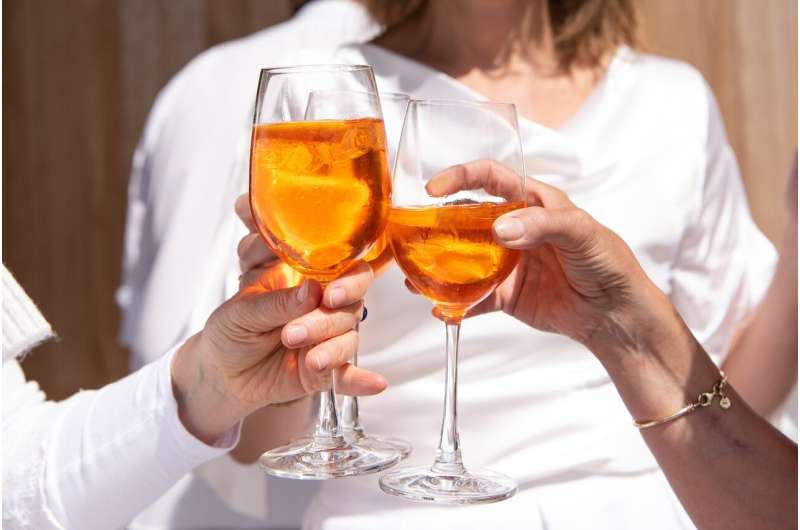Which beverages burst with umami potential?

A fifth basic flavor has crept into our conceptualisation of foods in recent years—umami. In Japanese, umami translates roughly to 'savory deliciousness'.
It is often associated with the earthy flavors of meat, mushrooms, broths and vine-ripened tomatoes. It enhances saltiness and sweetness, while reducing bitterness, which is why most people love it.
But does umami exist in beverages? And if so, which fermented beverage has the most umami potential: wine, beer, sake or champagne? And, what happens to flavors when these beverages are paired with foods?
Three researchers from the University of Copenhagen's Department of Food Science have published this first of a kind study in the journal Food Chemistry.
"We investigated the average umami flavor content in a range of wines, champagnes, beers and sakes. Our analyses demonstrate that it is in sake (Japanese rice wine), where umami reigns supreme on the umami scale, far ahead of beer, followed by champagne and finally wine. However, we studied slightly fewer beers than the other beverages, so that class of beverage may have been difficult to score precisely," reports postdoctoral researcher Charlotte Vinther Schmidt, one of the study's authors.
Higher potential when paired with food
Determining the umami flavor content of a drink involves finding out how much of an amino acid known as glutamic acid there is in it.
Umami flavor reaches us by way of glutamate as it lands on the specialized 'umami' taste receptors of our tongues.
"Our results suggest that the longer a beverage's fermentation time, the higher its glutamate content—which leads to more umami flavor. This is probably why sake leads the pack by so much in terms of umami, as it is typically fermented using both yeast and a mold culture called koji," explains Charlotte Vinther Schmidt.
But even if other beverages can't match sake's umami flavor on their own, UCPH's savory-deliciousness experts assert that the flavor can be provoked by pairing.
"We already know about food combinations which pair happily—like ham and cheese, for example. Therefore, we calculated the effects of pairing shellfish like oysters, shrimp and scallops with the various beverages, so as to investigate which combinations would synergize and provoke an emergence of umami. Here, we conclude that each of the beverage classes studied elicit an umami flavor when paired with oysters and tuna. Furthermore, sake, certain aged wines and champagne can also exhibit umami flavor when paired with scallops," explains CharlotteVinther Schmidt.
According to the researchers, this is because pairing high-content glutamate drinks with foods high in ribonucleotides (RNA's building blocks), catalyzes a synergistic flavor magic through which the best qualities of both drink and food emerge.
"If one takes a drink with glutamate and a food with just as many ribonucleotides, the umami flavor can generally be multiplied by eight," explains Charlotte Vinther Schmidt.
Useful knowledge for sustainable eating
Knowing how to enhance umami is useful when it comes to a more sustainable diet, as Charlotte Vinther Schmidt explains:
"If we can understand which vegetables, that together with selected beverages, provide the best taste—that umami contributes to—we could probably get far more people to consume vegetables, which is healthy for us humans, as well as for our planet."
So, there is good reason to consider the rapport between a meal's food and drink, as Charlotte Vinther Schmidt concludes:
"Although there are other factors contribute to taste experiences, like mouthfeel and smell, it might be a good idea to buy beverages with a high concentration of umami, as they improve the chance of enhancing taste in high-ribonucleotide foods, thus resulting in the delightful savory-deliciousness of umami."
Average umami flavor content in selected beverages:
The researchers studied 8 sakes, 9 types of white, rosé and sparkling wines, 9 champagnes and 5 types of beer. Here is the average umami content for each beverage class:
- Sake = 20.1
- Beer = 5.7
- Champagne = 4.2
- Wines = 3.5
More information: Charlotte Vinther Schmidt et al, Umami potential of fermented beverages: sake, wine, champagne, and beer, Food Chemistry (2021). DOI: 10.1016/j.foodchem.2020.128971
Provided by University of Copenhagen



















